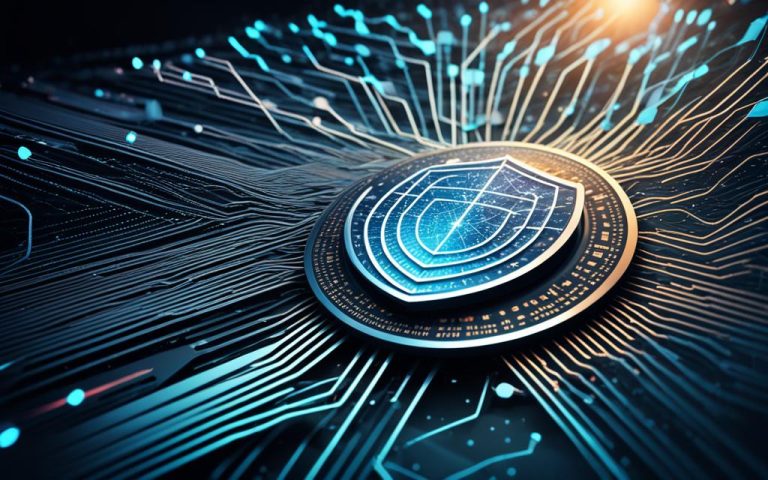Network engineers are key in the IT world. They design, deploy, and keep computer networks running smoothly. With AI technology growing, network engineering is changing. Tools like ChatGPT are now helping with network design and fixing problems faster.
ChatGPT, made by OpenAI, could soon be a must-have for network engineers. It can automate tasks and give personalized advice.
Key Takeaways:
- Predictive analysis and network automation are crucial trends in network engineering1.
- Cloud networking is becoming popular for managing hybrid networks1.
- The field is moving towards simpler methods for a greener future1.
- Using automation in networks is becoming more common, making networks more reliable and efficient2.
- Network engineers can earn good salaries, depending on where they work3.
Companies want better network performance and efficiency, so network engineering is adopting new trends and tech. Predictive analysis uses past data to forecast outcomes and guide decisions1. Automation is key, making routine tasks easier and letting engineers focus on big projects12.
Automation cuts down on manual work, reduces mistakes, and makes networks more scalable and consistent2. Cloud networking is also on the rise, mixing on-site and cloud networks for flexibility and savings1. This mix helps companies get the best of both worlds for their networks.
Chat-based AI tools like ChatGPT are changing network engineering too. They use natural language to help with network problems, improve settings, and make operations smoother1. AI helps engineers get advice and manage networks better, leading to less downtime and more efficiency.
Looking forward, network engineering looks bright with AI’s growth. AI can predict and solve network issues, making the job more efficient and dependable1. As companies go digital, the need for skilled network engineers will keep growing. Their pay varies by location and experience3.
In summary, network engineering is seeing exciting changes and future outlooks. Trends like predictive analysis, automation, cloud networking, and AI are reshaping the field. As engineers adapt to these changes, they’ll work more efficiently, improve network performance, and help networks run smoothly and securely.
The Emergence of ChatGPT in Network Engineering
Network engineering is changing fast with ChatGPT, an AI tool that uses GPT models to change how networks work. This new tech is making it easier for network engineers to solve complex problems and optimize networks4. ChatGPT helps engineers work better by automating tasks and offering AI advice4.
ChatGPT uses advanced deep learning to create text that sounds like it was written by a human. This makes it a great tool for network engineers4. It can understand complex network data, helping engineers fix issues and suggest better network setups4. But, it’s missing the real-world knowledge that human experts bring to the table4.
ChatGPT is great at automating tasks, but it can’t replace human network engineers. These pros have deep knowledge of business needs, complex designs, and how to fix problems4. When combined with ChatGPT, they can work more efficiently and effectively4. Human engineers bring the strategic vision needed for networks to run well4.
To get the most out of ChatGPT, humans and AI must work together. This teamwork lets engineers use AI’s power while keeping their human skills sharp5. The future of network engineering is about using AI like ChatGPT to make work easier and improve network performance5.
Stay tuned for more on ChatGPT and how it can help with troubleshooting, optimizing, and making network operations smoother4.
ChatGPT Basics: Understanding the Capabilities
ChatGPT, made by OpenAI, uses natural language processing to create a top-notch AI for network engineers. It can understand and make human-like text, changing how engineers work with AI in network tasks.
ChatGPT can write scripts automatically, helping engineers set up and keep networks running well. It gives step-by-step instructions and advice, making the setup process smoother and less prone to mistakes. Engineers just need to tell ChatGPT what they want, and it gives them the right commands and explanations. This makes networks run better and keeps problems away.
ChatGPT also helps predict security threats for network engineers. It looks at network data and spots possible weak spots, then suggests ways to fix them before they become big issues. This proactive approach strengthens network security.
When engineers face network issues, ChatGPT helps them solve problems faster. It knows a lot about different network issues and how to fix them. Engineers can talk to it in everyday language and get detailed help for their network troubles. This makes fixing problems quicker and reduces downtime6.
ChatGPT is not just for fixing problems. It also gives personalized help to engineers, adding to their skills in solving tough problems. It can act like an English college professor named Langston, making work with ChatGPT more fun and effective.
ChatGPT uses a “skillgraph” to connect different skills and knowledge areas. This framework shows how skills relate to each other, helping AI give better answers for specific tasks. Engineers can adjust ChatGPT to fit their network engineering needs, making it work better for them.
ChatGPT aims to be a versatile and skilled AI system, inspired by the Greek god Proteus. It’s designed to handle many tasks, making it a comprehensive tool for network engineers. This approach ensures a thorough and efficient way of tackling network challenges6.
Unlocking the Potential of Natural Language Processing
ChatGPT changes network engineering by giving engineers a powerful tool. It lets them talk to AI in a normal way, cutting out the need for hard programming or complicated interfaces. This makes network engineering easier and more straightforward.
With ChatGPT, network engineers can save time and resources in customer service. It can understand and answer different kinds of questions, making it great for chatbots. In fields like healthcare, education, and more, ChatGPT can offer personalized help, improving customer experiences7.
In eCommerce, ChatGPT can help customers find products, suggest items, and complete purchases. This makes shopping better and could lead to more sales. ChatGPT’s personal touch makes interactions more engaging and satisfying for customers.
Developers can use ChatGPT to create innovative chatbots for various industries. By using its natural language skills, they can build systems that make processes smoother, operations more efficient, and user experiences better. This can drive innovation and growth7.
Transformative Power of Transformer Models
Transformer models are at the core of ChatGPT’s strength. As computing power and Internet data have grown, so have Transformer architectures. The development of bigger and smarter Transformer models has changed AI capabilities8.
Transformer models use neural networks, which are key in smart AI systems. Training these networks on huge amounts of Internet text lets models like GPT learn on their own. This training, based on 570 billion words, has made GPT very skilled in understanding text and doing various tasks8.
While GPT can handle simple sentences, it needs more work to tackle complex tasks. Working with ChatGPT and GPT, OpenAI aims to improve natural language processing. This partnership lets network engineers use the full power of Transformer models, opening new doors in network engineering8.
Network Troubleshooting with ChatGPT
Network engineering is getting more complex, making troubleshooting harder. ChatGPT is stepping up, offering real-time support and automation. This helps keep networks running smoothly and cuts downtime.
ChatGPT uses AI and natural language processing to help network engineers. It has a deep knowledge base and an easy-to-use interface. This makes fixing network problems easier and faster.
ChatGPT can automate many routine tasks for network engineers, saving time9. Engineers can talk to ChatGPT, getting help with common problems and advice from its vast knowledge.
ChatGPT is always available, offering support 24/7. This means engineers can get help anytime, reducing downtime and fixing issues quickly. It works with network tools to diagnose problems, analyze logs, and create detailed reports.
Adding ChatGPT to network work makes things more efficient, improves communication, and makes networks run better10. For tough problems, engineers can count on ChatGPT for detailed help. It gives step-by-step guides and possible solutions, saving time and effort.
ChatGPT is also key in managing network configurations. It gives clear commands and advice, making it easier to manage network devices.
ChatGPT makes setting up networks easier by offering precise commands and syntax10. Engineers can talk to ChatGPT, getting expert tips on design and network optimization.
As AI gets better, ChatGPT will too, meeting the needs of network engineers. Adding more AI tools like machine learning and data analytics will help engineers manage networks better, improve security, and boost performance.
Optimizing Network Configuration with ChatGPT
Optimizing network configuration is key for keeping networks running smoothly and securely. ChatGPT has become a powerful tool for network engineers. It helps improve performance and reliability. By using ChatGPT, engineers can fine-tune settings, adjust parameters, and create custom configuration files for their needs.
ChatGPT uses advanced algorithms to analyze big data and offer insights for better network setup. It checks network performance, finds bottlenecks, and suggests ways to boost efficiency. These tips are based on the latest trends and best practices, keeping engineers up to date with new tech.
Security is a big deal when setting up networks. ChatGPT is great at spotting threats and helping with strong security steps. It knows a lot about network security, giving engineers advice to keep systems safe from attacks and weaknesses.
ChatGPT also helps with IoT devices, which are growing fast. Engineers need to connect and manage these devices well. ChatGPT uses its language skills to identify and manage IoT devices, ensure they work together well, and avoid connection problems.
Network engineering can be stressful, especially with complex cases and demanding customers. ChatGPT helps engineers deal with these tough situations. It uses past data and insights to suggest solutions, making it easier to please customers and solve problems quickly.
ChatGPT does more than just tweak settings. It helps with using network resources well, avoiding waste or too much capacity. With ChatGPT’s smarts, engineers can balance performance, cost, and growth.
As networks get more complex, working together is key for network and escalation engineers. ChatGPT makes this teamwork better by offering real-time advice. Engineers can work with escalation teams faster, using ChatGPT to quickly fix issues and cut downtime.
It’s interesting to note that Silicon Valley is known for its unique tech architecture styles. The “K” building is a great example, showing how form and function come together in the region.
Advantages of Optimizing Network Configuration with ChatGPT
| Benefits | Reference |
|---|---|
| Customized network settings | 11 |
| Enhanced security protection | 11 |
| Management of IoT interconnectivity | 11 |
| Efficient handling of complex cases | 11 |
| Resource deployment optimization | 11 |
| Collaboration between network and escalation engineers | 11 |
Optimizing network configuration is crucial in today’s fast-changing digital world. With ChatGPT, network engineers can keep networks running well, reduce risks, and lead in tech advancements. ChatGPT’s smarts and analysis give engineers the tools to fine-tune their networks and succeed in digital projects.
Streamlining Network Operations with ChatGPT
Today, making network operations efficient is key in a fast-changing tech world. With tech like 5G, IoT, cloud computing, and AI12, managing networks well is more important than ever. ChatGPT is a big help here, making it easier to keep an eye on and fix network problems.
ChatGPT helps network teams by making real-time data analysis better. This means quicker decisions and fast action on network issues. Adding AI and machine learning makes network management even better, helping teams spot and fix problems early12.
Handling network alerts well is crucial. Too many alerts can overwhelm teams and slow down fixing problems. But, with AIOps (Artificial Intelligence for IT Operations), teams can cut down on alerts, speed up solving problems, and automate routine tasks. This leads to fewer issues and quicker fixes13.
Generative AI and low-code/no-code tools make setting up networks easier and simplify hard tasks. Intent-based networking (IBN) lets admins set up networks with simple language, skipping the need for deep tech knowledge12. IBN and autonomous networks (AN) also help networks manage themselves, cutting down on manual work and making things run smoother12.
Day 0, Day 1, and Day 2 Operations
IBM talks about network service in three stages: Day 0, Day 1, and Day 2. Day 0 is about planning and designing networks for business needs. Intent-based networking makes this planning faster and more efficient12.
Day 1 is about starting new services and making sure they work well. Intents help automate making resource drivers for vendors, making service launches smoother12.
Day 2 is about keeping networks running well, focusing on performance, security, and reliability. Intent-based networking helps here too, giving operators the tools to manage networks better, fix problems, and improve user experience12.
To make network operations smoother, using the TMF921 Intent-based Networking API is a good idea. This API helps define network intents clearly, making it easier to work together across different networks and systems12.
Using ChatGPT to streamline network operations puts organizations ahead in the fast-paced world of network engineering. With AI and smart network management, they can improve their networks, boost performance, and give users a better experience.
Data Engineering Trends in 2024-2028
The field of data engineering is changing fast, thanks to new trends. These trends are changing how we handle, store, and analyze data. They will greatly affect businesses and the data world in the next few years.
Real-time data processing is becoming more popular. With more IoT devices and streaming data, companies want to analyze data right away. This helps them make quick decisions and improve customer experiences, giving them an edge14.
Cloud-native data engineering is also on the rise. As cloud platforms get better, companies use them to build and run data engineering projects. This approach lets businesses scale easily, save money, and use the many tools and services in the cloud14.
AI and machine learning are changing how we do data engineering. AI helps automate tasks, improve data quality, and make better decisions. By using AI and machine learning, companies can find important insights in complex data, driving innovation and staying ahead1415.
Data governance and privacy are big concerns now. With more data and its sensitivity, companies are focusing on strong data governance and following privacy laws. Data engineering is adapting to include processes and tech that ensure data safety and protect privacy15.
Serverless data engineering is becoming more popular. This approach lets companies leave infrastructure management to cloud providers. Data engineers can then focus on building and deploying data pipelines without worrying about servers. This makes it scalable, cost-effective, and reduces work, helping businesses innovate faster14.
Data quality and integration are still key in data engineering. With more data sources, companies need to make sure their data is reliable. Data engineers use tech and processes to clean and combine data from different sources, helping businesses make informed decisions14.
Edge computing is another big trend. As edge devices generate more data, companies use edge computing to process and analyze it closer to the source. This reduces delays and improves real-time decision-making. Edge computing lets businesses use IoT devices and edge analytics fully, offering better experiences to users14.
Key Data Engineering Trends for 2024-2028:
- Real-time data processing for immediate insights and decision-making.
- Cloud-native data engineering for scalability and flexibility.
- Integration of AI and machine learning to automate processes and derive insights.
- Data governance and privacy to ensure compliance and data security.
- Serverless data engineering for scalability and reduced operational overhead.
- Focus on data quality and data integration for reliable insights.
- Adoption of edge computing for processing data closer to the source.
The future of data engineering is exciting. As companies deal with more data, staying up-to-date with these trends is key. It will help them use data to innovate, make better decisions, and stay competitive in the fast-changing digital world1415.
| Statistical Data | Source |
|---|---|
| Pure Storage released a 75 TB Direct Flash Module, and NetApp introduced QLC-based C series systems. | 14 |
| Pure Storage aims to develop a 300 TB SSD by 2026. | 14 |
| QLC drives are becoming increasingly popular due to the need for large data capacity storage. | 14 |
| Block storage market is anticipated to remain stable in 2024, with cost and performance as key considerations. | 14 |
| Unstructured storage market is evolving towards combined file and object storage solutions. | 14 |
| IT vendors focus on providing ESG reports and sustainability metrics. | 14 |
| AI technology is expected to play a significant role in data storage trends. | 14 |
| Security market categories are experiencing confusion with overlapping products. | 15 |
| Vendors are integrating AI chat interfaces into their security and management software tools. | 15 |
| AI is used by hackers to enhance social engineering attacks like voice cloning. | 15 |
Impact of Data Engineering Trends on Business
Data engineering trends are changing how businesses work. They help companies use their data better. This leads to better decisions, smoother operations, and happier customers.
Real-time data processing is a big win. It lets businesses use data right away for quick insights. This helps them make fast, smart choices, putting them ahead in the market.
Cloud-native data engineering is also changing the game. It makes storing and handling big data cheaper and easier. This lets companies grow faster and innovate quicker.
Artificial intelligence (AI) and machine learning (ML) are making data engineering smarter. AI helps with tasks like writing code and finding bugs. ML looks at lots of data to make smart suggestions and personalize services, making customers happier16.
Data governance and privacy are key in data engineering. They help companies follow the rules and keep customers’ trust. This means setting clear rules for how data is used and kept safe17.
Serverless data engineering is becoming popular for its ease and cost savings. It lets companies focus on their work without worrying about the tech behind it. This makes things simpler and helps use resources better17.
Data engineering trends are unlocking the power of data for businesses. They help get valuable insights, make better decisions, and give customers great experiences. By using these trends, companies can stay ahead and innovate more in their fields.
Future Prospects of Data Engineering
Data engineering is growing fast and has bright future prospects. The need for more skilled people and the growing amount of data make this field exciting for those starting out. Data engineers earn a good salary because they are in high demand and have special skills.
Increased Demand and Skill Set
Knowing SQL, Python, and Java is key for data engineers. These languages help them work with big data. They also need to know about tools like Apache, Hadoop, and Spark to manage big data well.
Automation and AI are becoming more common, which might change the job market18. But, the need for cybersecurity and more IoT devices means data engineers have new challenges and chances to grow.
Specialization Opportunities
Data engineering lets you specialize in many areas. Trends like the Modern Data Stack and Analytics Engineer role are changing how data is handled19. These changes bring new roles and chances for data engineers to shine.
Jobs like Data Platform Engineer and MLOps Engineer are key for working with data and machine learning19. With Platform Engineering becoming more popular, data engineers can move into new roles. This shift focuses on making things better and faster in companies.
Career Outlook and Advancement
Computer network architects, including network engineers, are expected to see more job growth through 202420. This means a bright future for network engineers as they are needed more and more.
Certifications are important for doing well in network engineering. The CyberTex program offers training for 14 certifications, including Microsoft Azure and AWS20. These certifications help with specializing and moving up in your career.
Data engineering is a field that is always changing and offers many chances for growth and moving up. By keeping up with new tech and improving their skills, data engineers can have a successful and rewarding career ahead.
The 2024 Global Networking Trends Report
The 2024 Global Networking Trends Report gives us a deep look at the networking world today and what’s coming next. It’s a guide for IT leaders and professionals to stay ahead in the fast-changing networking scene. It helps them make smart choices about where to invest.
It shows the Networking as a Service (NaaS) market will grow to $78.38 billion by 2028, with a growth rate over 32%21. This points to a big move towards cloud-based networking and a need for flexible, scalable networks.
Also, 49% of IT leaders are thinking about moving to NaaS for their companies21. This move is seen as a way to save costs, be more agile, and improve security.
The report also talks about what network pros can earn in the U.S. Mid-level network engineers might make $85,000 to $95,000, while senior ones could earn $105,000 to $140,000. Network architects could get between $160,000 to $200,00021. These figures show the good career paths in networking and the need for skilled people.
It highlights skills like virtual networks, cloud networking, network automation, security, and cloud engineering as key21. Those with these skills will do well in the changing networking world.
Atlanta, Dallas-Fort Worth, and Seattle are where network pros can find lots of jobs21. These cities are full of job chances and have a strong networking community.
Also, the report talks about the importance of cloud skills and security21. Employers want people who can work with cloud systems and keep them secure.
Looking ahead, the report says there will be more demand for network managers, engineers, and architects21. This means the networking field will keep growing and offering more opportunities.
Experts say network engineers should move into security engineering quickly21. This field is in high demand and expected to grow a lot.
As the economy gets better after COVID-19, companies will hire more network pros21. This is good news for those looking for new jobs in networking.
Cloud adoption is rising, making cloud experience more valuable than ever21. This means network engineers with cloud skills are in high demand.
Working in hybrid and remote teams lets network pros work from anywhere21. This gives them more flexibility and opens up new chances for teamwork and innovation.
Key Insights from the 2024 Global Networking Trends Report
| Key Insights | Reference |
|---|---|
| The NaaS market is predicted to grow to $78.38 billion by 2028, with a compound annual growth rate of over 32% | 21 |
| 49% of IT leaders are planning or considering a NaaS transformation for their organizations | 21 |
| The most sought-after network skills include virtual networks, cloud networking, network automation, network security, and cloud engineering | 21 |
| Hot job markets for network professionals in the U.S include Atlanta, Dallas-Fort Worth, and Seattle | 21 |
| Companies are expected to increase hiring in 2024, especially in network infrastructure professionals, as the economy improves post-COVID-19 disruptions | 21 |
| As the trend for cloud adoption rises, the need for network engineers with cloud experience is on the rise, surpassing the demand for network administrators and architects | 21 |
The 2024 Global Networking Trends Report gives us a clear view of the networking world today and tomorrow. It helps organizations navigate the changes and make smart choices to move forward.
For more info on global networking trends in 2024, check out the TechTarget report and the ITProToday report.
| Link | Keyword |
|---|---|
| TechTarget report | global networking trends |
| ITProToday report | global networking trends |
Conclusion
The future of network engineering is changing fast. AI tools like ChatGPT are making big changes. They help troubleshoot, optimize networks, and make work more efficient.
With more devices connecting, we need skilled network engineers more than ever. Gartner predicts a big increase in demand. Network engineers will be key in managing the IoT’s growth.
They can handle up to 4,000 devices, showing their importance. It’s crucial for new engineers to keep learning and improve their skills.
Staying current with terms like PAT and getting better at troubleshooting is important. New tech like NFV, 5G, edge computing, and better cybersecurity will shape network engineering’s future. These technologies improve performance and security, helping engineers build strong networks.
Employers need to create a positive work environment to keep good employees. Offering good pay, growth chances, and skill development helps. This keeps employees happy and secure in their careers222324.
FAQ
How can ChatGPT assist network engineers in their work?
ChatGPT helps network engineers solve complex problems. It automates tasks like writing scripts and predicting security threats. It also offers advice on how to improve networks.
What are the capabilities of ChatGPT in network engineering?
ChatGPT can write scripts automatically, predict security threats, and optimize network settings. It gives step-by-step solutions to network issues. This improves troubleshooting skills.
How can ChatGPT help in network troubleshooting?
ChatGPT can understand technical issues and find out why they happen. It gives clear steps to fix network problems. It also works with tools to automatically diagnose and report on issues.
How does ChatGPT optimize network configuration?
ChatGPT helps network engineers set up networks better by adjusting settings and making custom files. It also manages IoT devices, improves network access, and stops connectivity problems.
How does ChatGPT streamline network operations?
ChatGPT makes monitoring networks better by analyzing data in real-time. This leads to quicker decisions and fast responses to events. Using cloud technology and AI makes networks more efficient.
What are the trends in data engineering for 2024-2028?
Trends include real-time data processing and using the cloud for data engineering. AI and machine learning are key, along with data governance and privacy. Data quality and edge computing are also important.
What is the impact of data engineering trends on businesses?
These trends help businesses make quicker decisions and run more efficiently. They automate tasks, follow rules, build trust with customers, simplify operations, and cut costs. This gives them an edge over competitors.
What are the future prospects of data engineering?
Data engineering is set to grow fast, thanks to more data and the need for skilled people. Knowing SQL, Python, Java, and other technologies is crucial for success in this field.
What is the significance of the 2024 Global Networking Trends Report?
The report shares insights from IT leaders on networking challenges and what they focus on. It shows how investing in IT affects businesses’ success. It’s a key resource for understanding networking now and in the future.
Is network engineering dying or evolving?
Network engineering is evolving, not dying. AI, especially ChatGPT, is changing the field. Engineers can use AI to improve their work, from fixing problems to optimizing networks. Data engineering is also key in handling and analyzing lots of data.
Source Links
- https://www.linkedin.com/pulse/future-network-engineering-derek-winchester – Future of Network Engineering
- https://sageuniversity.edu.in/blogs/future-of-networking-a-dive-into-network-automation – The Future of Networking: A Dive into Network Automation
- https://www.networkcuriosity.com/network-engineering-job-questions/ – Network Engineering Job Questions – Network Curiosity
- https://www.toolify.ai/gpts/the-rise-of-chatgpt-revolutionizing-network-engineering-125522 – The Rise of ChatGPT: Revolutionizing Network Engineering!
- https://www.linkedin.com/pulse/prompt-engineering-dead-long-live-people-skills-dr-charles-handler-mx2tc – Prompt Engineering is Dead! Long Live Prompt Engineering! (and people skills)
- https://medium.com/@wisak_/think-youve-mastered-chatgpt-meet-langston-and-think-again-500777ea9380 – Think You’ve Mastered ChatGPT? Meet Langston and Think Again
- https://trackier.com/Resources/Reports_Guides/ChatGPT.pdf – Guide – Chat GPT
- https://pswordpress-production.s3.amazonaws.com/2023/04/How-ChatGPT-works.pdf – PowerPoint Presentation
- https://medium.com/@techrobot45/how-chatgpt-could-replace-it-network-engineers-73d60b07eb2d – How ChatGPT could replace IT network engineers
- https://www.toolify.ai/gpts/revolutionize-network-engineering-with-chat-gpt-125571 – Revolutionize Network Engineering with Chat GPT
- https://subnetzero.info/page/2/ – Goodbye, Building K
- https://medium.com/@agarapuramesh/harnessing-ai-for-autonomous-network-operations-98b8009fb40d – Harnessing AI for Autonomous Network Operations
- https://www.cio.com/article/2108334/4-ways-ai-will-change-the-itops-landscape-in-2024.html – 4 ways AI will change the ITOps landscape in 2024
- https://futurumgroup.com/insights/2024-trends-and-predictions-for-data-storage/ – 2024 Trends and Predictions for Data Storage
- https://gigaom.com/2023/12/08/five-security-networking-and-management-predictions-for-2024/ – Five security, networking and management predictions for 2024
- https://brainhub.eu/library/software-developer-age-of-ai – Is There a Future for Software Engineers? The Impact of AI [2024]
- https://symphony-solutions.com/insights/data-engineering-best-practices – 10 Data Engineering Best Practices for Your Business | Symphony Solutions
- https://www.layer8packet.io/home/is-network-engineering-a-dying-field – Is Network Engineering a Dying Field? — Layer8Packet
- https://robertsahlin.substack.com/p/the-data-engineer-is-dead-long-live – The Data Engineer is dead, long live the (Data) Platform Engineer
- https://cybertex.edu/why-network-engineering-remains-a-good-career-choice-in-2024/ – Why Network Engineering Remains a Good Career Choice in 2024? – CyberTex
- https://www.techtarget.com/searchnetworking/feature/Networking-pros-face-strong-job-market-greater-demands – What the networking job market looks like for 2024 | TechTarget
- https://www.linkedin.com/pulse/where-have-all-network-engineers-gone-kent-adams – Where Have All the Network Engineers Gone?
- https://www.layer8packet.io/home/the-future-of-network-engineering-exploring-upcoming-trends-and-technologies – The Future of Network Engineering: Exploring Upcoming Trends and Technologies — Layer8Packet
- https://medium.com/geekculture/the-dead-sea-effect-d71df13724f8 – The Dead Sea Effect



















